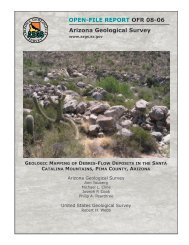geothermal resource potential of the safford-san simon basin, arizona
geothermal resource potential of the safford-san simon basin, arizona
geothermal resource potential of the safford-san simon basin, arizona
Create successful ePaper yourself
Turn your PDF publications into a flip-book with our unique Google optimized e-Paper software.
sional origin.<br />
Geo<strong>the</strong>rmal systems are frequently localized by Quaternary or<br />
Recent faults.<br />
Geologic evidence shows that <strong>the</strong> <strong>the</strong>rmal well area at Buena Vista overlies<br />
a structural bench south <strong>of</strong> <strong>the</strong> Gila Mountains and bound by major fault<br />
zones on <strong>the</strong> north, south and east.<br />
Approximately 213 m <strong>of</strong> <strong>basin</strong>-filling<br />
sediments overlie<br />
<strong>the</strong> bench which is mostly composed <strong>of</strong> "Laramide" volcanic<br />
rocks and related intrusions.<br />
Nearby in <strong>the</strong> Gila Mountains, "Laramide" volcanic<br />
rocks are highly fractured with numerous nor<strong>the</strong>ast-trending shear zones<br />
and faults (Dunn, 1978; Robinson and Cook, 1966).<br />
These rocks are frequently<br />
altered pervasively and mineralized along shear zones<br />
(Dunn, 1978; Robinson<br />
and Cook, 1960).<br />
If <strong>the</strong> Laramide rocks underlying <strong>the</strong> structural bench are<br />
similarly fractured and sheared, which is an inescapable conclusion considering<br />
that <strong>the</strong> area lies astride <strong>the</strong> intersection <strong>of</strong> <strong>the</strong> Morenci lineament and a<br />
linear discontinuity <strong>of</strong> <strong>the</strong> Texas Zone, a deep <strong>geo<strong>the</strong>rmal</strong> reservoir possibly<br />
underlies <strong>the</strong> structural bench (Figure 6).<br />
The Butte fault and <strong>the</strong> San Jose<br />
fault zones may also contain a deep <strong>geo<strong>the</strong>rmal</strong> reservoir,especially near<br />
<strong>the</strong>ir intersection.<br />
A third possible <strong>the</strong>rmal water source for <strong>the</strong> shallow<br />
reservoir at Buena Vista is <strong>the</strong> Safford Basin.<br />
Thermal water may migrate upward<br />
from <strong>the</strong> <strong>basin</strong> interior through <strong>the</strong> basal conglomerate and into sediments<br />
marginal to <strong>the</strong> <strong>basin</strong> such as those at Buena Vista.<br />
In this case hydraulic<br />
connection is required between <strong>the</strong> gravels deeply buried in <strong>the</strong> <strong>basin</strong> with<br />
sediments on <strong>the</strong> structural bench.<br />
If <strong>the</strong>se later conditions exist, <strong>the</strong><br />
necessity <strong>of</strong> a deep and leaky bedrock reservoir in <strong>the</strong> structural bench or<br />
fault zones is not required and <strong>the</strong> maximum <strong>geo<strong>the</strong>rmal</strong> reservoir temperature<br />
at Buena Vista probably will not exceed 55 0 C.<br />
Reiter and Shearer, 1979, discuss <strong>the</strong> <strong>the</strong>rmal regime <strong>of</strong> a deep well 3.5<br />
miles east <strong>of</strong> Buena Vista. A heat flow <strong>of</strong> five HFU is reported for <strong>the</strong> 300-<br />
46

















